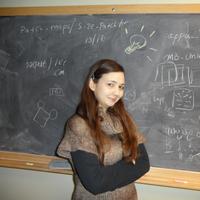Papers by Michael J Hudson
The Astrophysical …, Jan 1, 1998
A tangential distortion of background source galaxies around foreground lens galaxies in the Hubb... more A tangential distortion of background source galaxies around foreground lens galaxies in the Hubble Deep Field is detected at the 99.3% confidence level. An important element of our analysis is the use of photometric redshifts to determine distances of lens and source galaxies and rest-frame B-band luminosities of the lens galaxies. The lens galaxy halos obey a Tully-Fisher relation between halo circular velocity and luminosity; the typical lens galaxy, at a redshift z = 0.6, has a circular velocity of 210 ± 40 km s −1 at M B = −18.5, if q 0 = 0.5.
The Astrophysical …, Jan 1, 2007
Page 1. THE MASSES AND SHAPES OF DARK MATTER HALOS FROM GALAXY-GALAXY LENSING IN THE CFHT LEGACY ... more Page 1. THE MASSES AND SHAPES OF DARK MATTER HALOS FROM GALAXY-GALAXY LENSING IN THE CFHT LEGACY SURVEY Laura C. Parker Department of Physics and Astronomy, University of Waterloo, Waterloo ...
The Astrophysical …, Jan 1, 2005
We present the findings of our weak lensing study of a sample of 116 CNOC2 galaxy groups. The len... more We present the findings of our weak lensing study of a sample of 116 CNOC2 galaxy groups. The lensing signal is used to estimate the mass-to-light ratio of these galaxy groups. The best fit isothermal sphere model to our lensing data has an Einstein radius of 0. ′′ 88±0. ′′ 12, which corresponds to a shearweighted velocity dispersion of 245±18 km s −1 . The mean mass-to-light ratio within 1 h −1 Mpc is 185±28 hM ⊙ /L B⊙ and is independent of radius from the group center.

The Astrophysical …, Jan 1, 2006
We present the first measurements of the weak gravitational lensing signal induced by the large s... more We present the first measurements of the weak gravitational lensing signal induced by the large scale mass distribution from data obtained as part of the ongoing Canada-France-Hawaii Telescope Legacy Survey (CFHTLS). The data used in this analysis are from the Wide Synoptic Survey, which aims to image ∼ 170 square degree in five filters. We have analysed ∼ 22 deg 2 (31 pointings) of i ′ data spread over two of the three survey fields. These data are of excellent quality and the results bode well for the remainder of the survey: we do not detect a significant 'B'-mode, suggesting that residual systematics are negligible at the current level of accuracy. Assuming a Cold Dark Matter model and marginalising over the Hubble parameter h ∈ [0.6, 0.8], the source redshift distribution and systematics, we constrain σ 8 , the amplitude of the matter power spectrum. At a fiducial matter density Ω m = 0.3 we find σ 8 = 0.85 ± 0.06. This estimate is in excellent agreement with previous studies. Combination of our results with those from the Deep component of the CFHTLS enables us to place a constraint on a constant equation of state for the dark energy, based on cosmic shear data alone. We find that w 0 < −0.8 at 68% confidence. Subject headings: cosmology: observations − dark matter − gravitational lensing † Based on observations obtained with MegaPrime equipped with MegaCam, a joint project of CFHT and CEA/DAPNIA, at the Canada-France-Hawaii Telescope (CFHT) which is operated by the
Arxiv preprint astro-ph/0412329, Jan 1, 2004
We compare the measured peculiar velocities of 98 local (< 150h −1 Mpc) type Ia supernovae (SNIa)... more We compare the measured peculiar velocities of 98 local (< 150h −1 Mpc) type Ia supernovae (SNIa) with predictions derived from the PSCz. There is excellent agreement between the two datasets with a best fit β I (= Ω 0.6 m /b I ) of 0.55±0.06. Subsets of the SNIa dataset are further analysed and the above result is found to be robust with respect to culls by distance, host-galaxy extinction and to the reference frame in which the analysis is carried out.











Uploads
Papers by Michael J Hudson